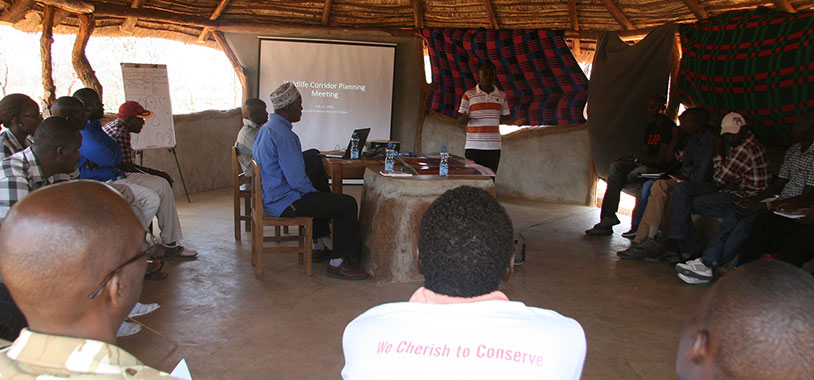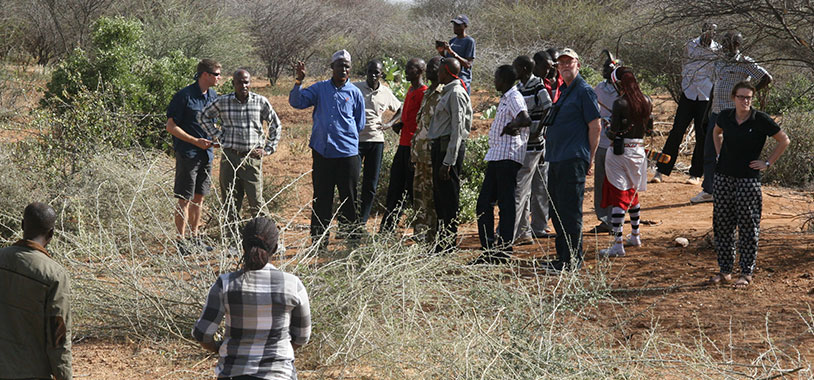Throughout the last year conservation organisations have been discussing the LAPSSET (Lamu Port South Sudan Ethiopia Transport Corridor) railway line and oil pipeline construction. This construction concerns us all because of the rich wildlife areas that the route will cut through. Save the Elephants has been established for almost 20 years in Samburu and has collected a gold mine of radio-tracking data for the area. Recently, we were funded by the Nature Conservancy to deploy 30 new collars within different community conservancies in order to get a better idea of how elephants are utilizing the landscape, and help define the wildlife corridors that would be necessary for them to survive the coming of this infrastructure.
At the beginning of this year STE called for a meeting with our core partners the Northern Rangelands Trust and Lewa Wildlife Conservancy (kindly hosted by Lewa). The goal of this meeting was to share some of our data in order to show the historical wildlife corridors that LAPSSET construction will be severing if preventative measures aren’t taken. We also discussed prioritizing which corridors needed the most protection based on how frequently they are used by elephants and other wildlife. It was the first of many such meetings to collect data from other partners, such as Ewaso Lions and the Grevy Zebra Trust, about animal movements, before working with TNC’s Development by Design team and presenting ideas to the LAPSSET planners.
In addition to the LAPSSET project, we discussed our fear that roadside development will continue to obstruct vital corridors used by wildlife. Such ‘ribbon development’ is rapidly growing due to the opportunities provided by tarmac roads and an increase in human population.
Over the course of this meeting it was decided that STE-in collaboration with other conservation NGO’s should arrange a local forum to address ribbon development. In the meantime, STE, Nature Conservancy and Lewa should direct their concerns towards the conservation alliance of Kenya, which will speak directly with the national government.
On the local level, we held our first informative meeting during the beginning of January with KWS, community members, and the Samburu reserve management. Unfortunately, representation of local board members was lacking during the meeting, preventing us from coming to a proper conclusion. Since protection of wildlife corridors from ribbon development is an urgent matter, we decided to meet again in February. STE was given the responsibility to plan this meeting and immediately we started reaching out to board members whose communities are located around areas where wildlife frequently crosses. We also reached out to other stakeholders in this region whose voices are relevant, including Ewaso Lions, Grevy’s trust and Kenyan Wildlife Service.
On February 11th, the STE team left very early in the morning and headed for Kalama to set up for the meeting. Members started streaming in at around 9:30 and by 10:00 we had a satisfactory attendance to start the meeting. Despite a few members lacking from the South, we decided to continue with the meeting. I was facilitating for STE and after a brief introduction from everyone we presented a slide show. This sparked interesting discussion revolving around the subject of establishing wildlife corridors. After two hours, we came to the end of the slide show at which point members from the South finally arrived and requested that we repeat the presentation. For the benefit of having everyone on the same page, we obliged. Coincidentally, a power line company was traveling through the area during the time of the meeting and we asked for them to brief us on their work. Questions were raised revolving around the environmental impact of their project and they answered these questions as well as provided contact information for us to engage in future discussions.

Afterwards, we broke for lunch and reconvened around 3:30 to visit elephant crossing sites in the area. Starting from the North close to Kalama we traveled south towards Ngare-Mara, familiarizing members on the ground with the information that they saw on the slides. Unfortunately, at our last site close to Ngare-Mara Bridge we came across hostile community members who informed us that this particular area that wildlife frequently cross was already planned for development. We decided not to argue on the roadside and left the issue to be discussed in a more appropriate forum. At this time, David closed the meeting and thanked the members for contributing. In conclusion, this meeting was very productive and we felt that we had established an action plan to be implemented before the next meeting.


